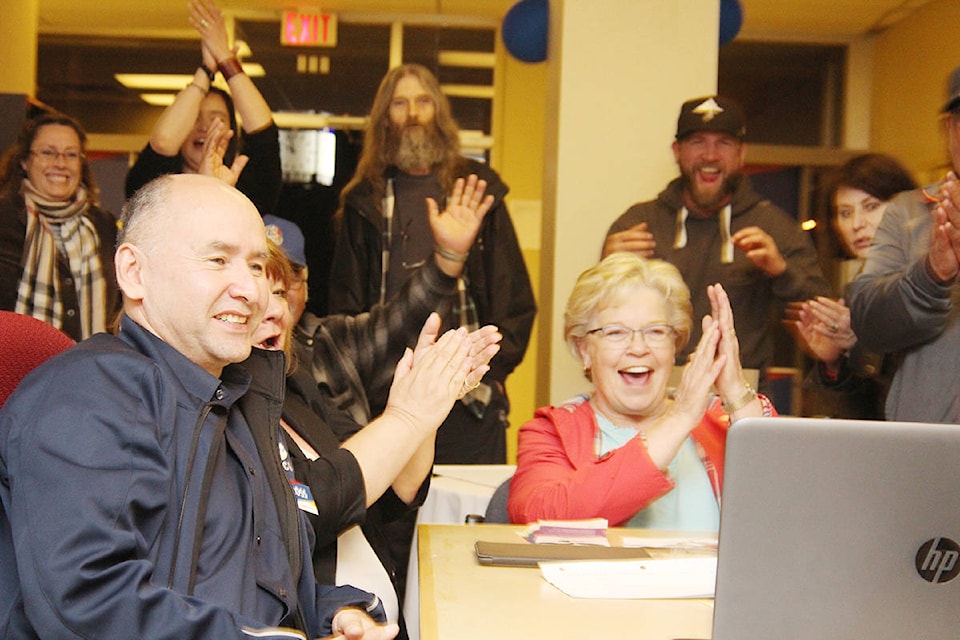Newly-elected Skeena riding MLA Ellis Ross has not been idle while B.C. waited for the final counting of votes to determine whether the Liberals would have a majority government or not.
Ross said he and his staff have been busy with securing office space to use as a base of operations in Skeena.
“There will be two MLA offices, one in Kitimat and one in Terrace. Our staff are still negotiating lease agreements,” said Ross.
“The office location isn’t about my personal choice - it’s more about accessibility.”
He did say, however, that leasing the previous MLA office in Terrace would make sense, as people were familiar with it.
He added that the Kitimat office would probably be in the central business district and that there was really only one potential location that would be suitable.
“I’d prefer if the process is simple and straight to the point,” said Ross.
“I want to find the office and be quick about it so that I can sit down and get to work.”
He said his time has also been taken up arranging meetings with organizations throughout the riding that had sought him out before the elections, to discuss possible ways for co-operation between communities and provincial government.
“Waiting for the recount, I’ve been using the time going around to the organizations to find out where they want to head,” added Ross.
In Terrace, Ross said he wants to work on developing industry and to fast track the construction of the hospital.
“The announcement of the construction of the hospital is great, but the organizations involved need to hit the ground running,” said Ross.
“I need to know about timelines.”
“With Kitamaat Village I have a pretty good idea of what the village wants. I have always known what the village has wanted,” said Ross.
He said as far as plans for Kitimat are concerned, he knows the construction or upgrading of the Haisla bridge is a priority.
“I would love to see the real numbers and a plan for the bridge,” said Ross.
He was encouraged with news that the District is keen on diversifying the Kitimat economy, having himself worked previously on plans to develop a private port as part of a diversification strategy.
He said he was also intent on meeting with First Nations village governments throughout the riding.
“I want to meet with them and see what they have prioritized with the B.C. government,” said Ross. “I know there are a lot of issues they want resolved.”
He added, however, that all his plans were dependent on the finalization of the recount and the formation of a provincial government.
Following the counting of absentee ballots completed last week, BC Liberal Party retained 43 seats, with the NDP and the B.C. Green Party retaining 41 and 3 seats respectively. Ross said a slim majority will require MLAs to attend regularly, especially when voting, which he said will require a lot of travel, something which his family is prepared for.
“I’ve never been a fan of flying, or traveling, but I knew this job would involve both going into the elections,” said Ross.
By Rod Link
Last week’s final count for the May 9 provincial election had New Democrat challenger Bruce Bidgood cutting just slightly into Ross’ winning margin.
On election night Ross topped the polls with 6,370 votes to Bidgood’s 5,089, but a count of absentee ballots on May 22 revealed Bidgood taking that category by 524 votes to Ross’s 402.
When the absentee ballots were added to the regular ones, Ross came out with 6,772 votes, or 52.23 per cent of ballots cast, to Bidgood’s 5,613, or 43.29 per cent of ballots cast.
Merv Ritchie of the Land Air Water party finished with 580 votes, or 4.47 per cent of ballots cast.
Overall, 12,965 ballots were cast in Skeena in this election, representing a 64.8 per cent voter turnout, a healthy increase over the last election in 2013 when 55.85 per cent of Skeena voters turned out to the polls.
Absentee ballots are defined as those cast either outside of the electoral district or not a person’s assigned voting place either on election day or during advance voting days.
Final count is a count of absentee ballots for an election that were not considered at initial count. The final results of an election are determined at final count based on the votes accepted at initial count and final count.
Final count begins on Day 41 of the election period, and is conducted by the district electoral officer.
At the end of final count, the district electoral officer can declare a candidate elected.
Ballots considered at final count include:
Absentee – Out of voting area: Voting within the voter’s electoral district but not at the voter’s assigned voting place (Election Act, s. 99)
Absentee – Out of electoral district:
Voting outside of the voter’s electoral district (Election Act, s. 100)
Advance absentee – Out of the electoral district: Voting at advance voting outside of the voter’s electoral district (Election Act, s. 101)
Alternative absentee voting: Voting in the office of the district electoral officer between Writ Day and 4 p.m. (Pacific time) on General Voting Day (Election Act, s. 104)
Alternative absentee voting by voting package: Vote by Mail (Election Act, s. 106)
Special voting: Mobile teams visit locations with voters unable to attend another voting opportunity,such as hospitals, isolated communities, logging and fishing camps (Election Act, s. 98).
